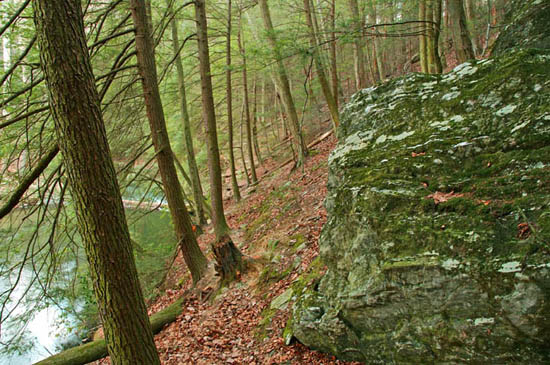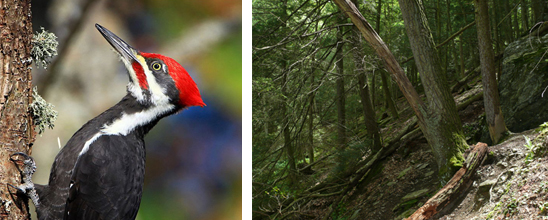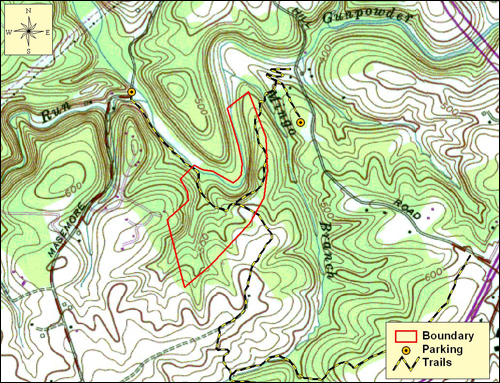Masemore Hemlock Ravines, Baltimore County
 Masemore Hemlock Ravines Natural Area has the look and feel of a mountain forest despite its location in northern Baltimore County. Steep, rocky slopes lined with eastern hemlock, chestnut oak and mountain laurel give way to small ravines. Adjacent moist and rich forests of tuliptree and northern red oak support numerous wildflowers. In the early spring, casual hikers can see an array of erect trillium, Dutchman's breeches, bloodroot, Canada mayflower and wild ginger blanketing the forest and floodplain floor. The forest system also supports numerous species of songbirds and woodpeckers, including the impressive, crow-sized pileated woodpecker. Throughout the year, and especially during the breeding season, visitors may hear the pileated's loud drumming or laughter-like call echoing through the forest. Hiking trails east and west of Masemore Road afford visitors access to the interior of these old-aged forests as well as several scenic vistas of the Gunpowder River.
Masemore Hemlock Ravines Natural Area has the look and feel of a mountain forest despite its location in northern Baltimore County. Steep, rocky slopes lined with eastern hemlock, chestnut oak and mountain laurel give way to small ravines. Adjacent moist and rich forests of tuliptree and northern red oak support numerous wildflowers. In the early spring, casual hikers can see an array of erect trillium, Dutchman's breeches, bloodroot, Canada mayflower and wild ginger blanketing the forest and floodplain floor. The forest system also supports numerous species of songbirds and woodpeckers, including the impressive, crow-sized pileated woodpecker. Throughout the year, and especially during the breeding season, visitors may hear the pileated's loud drumming or laughter-like call echoing through the forest. Hiking trails east and west of Masemore Road afford visitors access to the interior of these old-aged forests as well as several scenic vistas of the Gunpowder River.

Fewer than 20 stands of eastern hemlock have been documented in the Piedmont portion of Maryland, totaling about 215 acres. While many of these stands are now isolated, it is believed that they were once part of a widespread forest that occurred during the middle to late Pleistocene Epoch. Most of Maryland's hemlock stands can be found in the mountainous western region of the state. Masemore Hemlock Ravines is part of Gunpowder Falls State Park, which offers terrific outdoor recreation opportunities.
Ephemeral Beauty
Many of the spring wildflowers at Masemore Hemlock Ravines Natural Area are spring ephemerals, meaning that they flower and fruit in early spring before the trees leaf out. This natural strategy allows the tiny plants to take advantage of the extra sunlight reaching the forest floor before the tree canopy develops and shades out the area.

A Tiny Terror!
The eastern hemlocks that give this Natural Area its name are now under threat from the invasive hemlock woolly adelgid. These tiny insects were accidentally introduced from East Asia in 1924. While feeding on the sap of hemlocks, adelgids inject a toxin that prevents the trees from producing new growth. Without treatment, the trees will die within 4-10 years. Ecologists have had success with introducing the adelgid's natural predator: the tooth-necked fungus beetle. These tiny, dark beetles specialize in feeding on woolly adelgid eggs, larvae and adults.

Click here for a Print Version of this map.

Directions
From Baltimore: Travel I-695 (Baltimore Beltway) to Exit 24 and head north on I-83 about 12 miles. Take Exit 27 and turn left at the end of the ramp onto MD 137 (Mt. Carmel Road), heading west. After 0.7 miles, turn right (north) onto Masemore Road and continue about 1.4 miles to the parking area and Gunpowder South trailhead.
Acknowledgments
Scenic View of Masemore Hemlock Ravines. Photo by: Gary Fleming
Wildlife Collage One: (left to right)
Both male and female pileated woodpeckers have striking, red crests. Special growth cells on the ends of their chisel-shaped bills keep them from being worn down by the constant contact with a tree's tough bark. Photo by: Wikimedia Commons
Eastern hemlocks tower over the forest floor. If spared by disease �or logging, the trees can grow to over 100 feet tall. Photo by: Jason Harrison
Wildlife Collage Two: (left to right)
Pinxter flower is a beautiful wild azalea that can be found in bloom along the trails in mid-spring. Photo by: Jason Harrison
Bloodroot flowers brighten up the forest floor in early spring. Photo by: Kerry Wixted
The pink or white flowers of the spring-blooming mountain laurel can be easily seen along the slopes of Masemore Hemlock Ravines. Photo by: Nicholas T./Wikimedia Commons
Wildlife Collage Three: (left to right)
The cotton-like coverings indicate the presence of woolly adelgids on the branch of an eastern hemlock. Photo by: Wikimedia Commons
A tooth-necked fungus beetle voraciously feeds on adelgids. Photo by: M. E. Montgomery, USFS